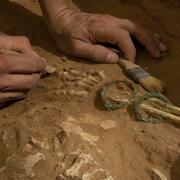Technological advances in DNA sampling have given a tremendous, if sometimes controversial, boost to early human history. I find this both deeply intellectually fascinating, and also oddly existentially comforting--to see the deep history of humanity as a species, it gives me a sense of the miniscule importance, in the long run, of events today--and, where they may not be miniscule (as in climate change), the importance of events on a timescale larger than everyday human existence typically allows us to imagine.
The title of this post is from Leonard Cohen's song "Nevermind." When I first heard it, I thought it might be imagining the thoughts of a soldier from the Yugoslav wars, or something like that--some contemporary conflict involving atrocities and annihilation. But listening to it repeatedly (I listen obsessively to songs, sometimes), I came to imagine it as sung by a Neanderthal--a member of a species which, recent archaeology strongly suggests to me, Homo Sapiens either directly annihilated or indirectly encouraged towards extinction. The fact that much of humanity (the part that left Africa in the deep past) carries in it a certain percentage of Neanderthal DNA suggests a complicated story there--and suggests how we ourselves bear within us a deep history that is never completely past.
All of this today is interesting because of a small piece I read today in the NYTimes. It's about a DNA analysis of a Philistine site in modern-day Israel. The concrete findings are mildly interesting--some of the Philistine ancestors seem to have come from over the Mediterranean, from Europe, at the end of the Bronze Age. (The scholarly article that it discusses, for real nerds, is here.) We've long known that the end of the Bronze Age was the next-to-last, and perhaps the more truly devastating, "Dark Age" that humanity faced in the Mediterranean world. It's still quite a controversial topic, but totally gripping, at least imho.
The NYTimes article is fascinating in a number of ways. But for me the most poignant thing is not in the article, but in one of the images in the article. You only see an archaeologist's hands, carefully brushing away dirt from a set of bones, embedded in the dirt. Arm bones. Then you compare the size of the hands to the bones, and you realize: that must be an infant's arm. And then you see there are two bracelets on the arm. And then you realize that someone must have loved the small child, or felt at least some need to honor someone who had died, who was barely beyond a baby, with what must have been among the most precious objects they had.
Sometimes time seems utterly to sever us from the past, so that the 1970s are on another world. And sometimes three thousand years seems as nothing.
